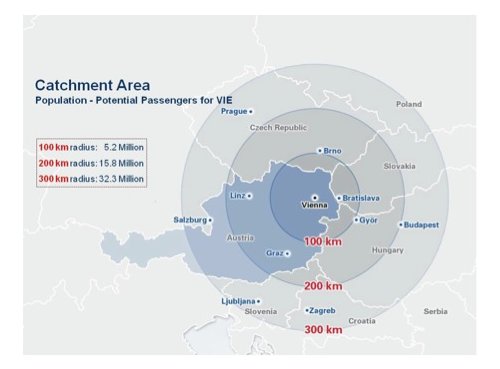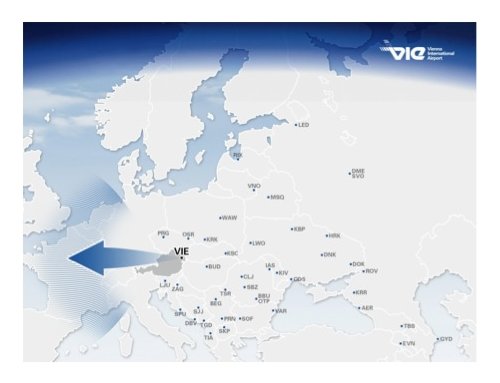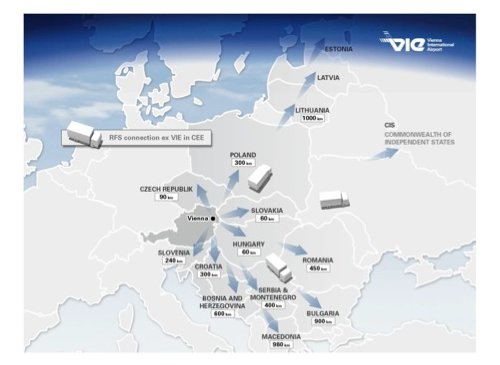Catchment Area
Due to Vienna's ideal location in the East of Austria, Vienna International Airport serves as the primary hub to the dynamic regions of Slovakia, Western Hungary and the Southern Czech Republic. VIE has direct access to important transport corridors to the East and is located directly in the growth markets of Central and Eastern Europe.

Vienna International Airport has a number of important advantages over other airports: it boasts an ideal geographic position in a region of sustained economic growth as well as competitive tariffs and incentives for airlines, steady infrastructure and high-quality, on-schedule service with a minimum connecting time of 25 minutes, unequalled in Europe.
Market Info
The fact that Vienna is a fashionable tourist destination and a popular choice for international congresses constitutes an additional asset for the airport itself. In the Mercer Worldwide Quality of Living Survey 2010, Vienna retains the highest global ranking, followed by Zurich and Geneva. Politically and economically stable, the city is also the seat of about 30 international organisations, including the UN, OSCE, and OPEC. Its international prestige and appeal as a city imbued with history, art, and music make Vienna highly attractive to both holidaymakers and business travellers. Because of its close proximity to the city, Vienna International Airport acts as a gateway here. For those wishing to use public transport, the City Airport Train with its frequent connections allows passengers to travel comfortably from the airport to central Vienna or vice versa in only 16 minutes.
With its modern and efficient infrastructure, its vicinity to growing CEE markets and expertise in these markets, VIE is considered as an economic gateway to the East. Vienna is the Central European Base for approximately 300 Multinational Companies and the location for around 30 International Organizations - capitalizing on know-how, commitment to quality, first-rate technology and state-of-the-art infrastructure. Moderate corporate taxation, attractive research incentives and efficient public services make the framework for the economic success of companies.
10.5% Passenger Increase in June 2010
As passenger traffic declined globally due to the worldwide financial and economic crisis, the number of passengers using Vienna International Airport fell by 8.3% to 18.1 million in 2009, which is less than the predicted 9%. During the six months period from January to June 2010, Vienna handled a total of 8,899,368 passengers, which equals an increase of 5.5% compared to the same period in the previous year. In June, the rate of growth reached 10.5%. The Flughafen Wien Group is presently anticipating a moderate recovery in air traffic for the 2010 financial year. The cargo sector has already reported an excellent growth rate of 30.4% during the first half of 2010, with higher market shares for Vienna International Airport.
Traffic Figures for the 1st half of 2010:
|
Jan-Jun 2010 |
2009 |
2010 |
∆ % |
|
Movements |
119.351 |
119.167 |
-0.2 |
|
Passengers (total) |
8.432.747 |
8.899.368 |
5.5 |
|
Transfer passengers |
2.518.900 |
2.677.072 |
6.3 |
|
Local passengers |
5.888.254 |
6.202.954 |
5.3 |
|
Cargo (in tons) |
113.770 |
148.353 |
30.4 |
Network
Vienna International Airport is widely recognised as the only airport in CEE, combining a dense route network with a perfect infrastructure. With 43 CEE destinations (source: OAG, summer 2010), VIE continues to expand its leading position to the CEE region. In 2009 around 79 airlines offered flights to more than 180 destinations (scheduled traffic) all over the world.
Vienna International Airport has been able to attract a number of new airlines and expand its range of flight connections this year. With the inception of the 2010 summer schedule, British Midland International and Alitalia have launched regular flights to Vienna. Moreover, Austrian Airlines has increased the number of flights as well as its flight capacity to 36 destinations while Niki is set to maintain its growth momentum with a further fleet augmentation in 2010. Connections to Turkey have been significantly improved with SunExpress taking up flights to and from Vienna this summer. Since June 2nd 2010, Wataniya Airways has been connecting Vienna and Kuwait City. Russian S7 Airlines introduced weekly flights from Vienna International Airport to Novosibirsk on June 12th 2010. As of September 16th 2010, KAM Air will be operating three flights per week between Vienna and the Afghan capital of Kabul.

Facilities
Vienna International Airport has two runways with a maximum capacity of 66 movements per hour. There are 20 air bridges and 61-69 remote positions. VIE has a minimum connecting time of 25 minutes which represents a top rating in European comparison. Short taxi times, a top departure punctuality rate and short walking distances for local and transfer passengers are further assets of VIE.
Cargo
With its modern technology, capacity and expertise, Vienna International Airport is the most important cargo hub in CEE and offers many advantages: a logistics area with direct apron connection, 24-hour customs office, short acceptance deadlines for export cargo, short delivery times for import cargo and a direct link to the motorway network.

The cargo segment is reporting excellent growth with an increase of 30.4% in the first half year. At present six cargo airlines offer around 55 frequencies per week.
In May 2010 Vienna International Airport was awarded Best Cargo Airport in the category 'up to 300,000 metric tonnes of cargo' by Air Cargo News.
Unserved Routes/Key Market Opportunities
For information about airline opportunities, please contact us directly: [email protected]
Please also have a look at our website: www.viennaairport.com




